Frequently
Asked Questions
Answers to frequently asked questions – if you are missing any questions and its answer please feel free to contact us.
1. General
1.1 - What does Visar Sorting Sàrl do?
Visar Sorting Sàrl develops and manufactures optical sorting machines (qualitative sorting, grading and integrated weighing) for carrots and potatoes: Sortop Carrots, Sortop Potatoes and Sortop Multi. With their very high performance you increase your yield, the market value and you reduce food waste. Swiss made of course! Visar Sorting Sàrl offers you a service from A to Z: High quality and maximum efficiency in personalization, integration, project monitoring and after-sales service.
From A to Z is done in-house:
- Research and development
- Development of the unique software Visar VACS
- Automation and electrics
- Mechanical design
- Final assembly and tests
- Marketing and Sales
- After-sales service
1.2 - Who is Visar Sorting Sàrl?
Visar Sorting Sàrl is an innovative and highly flexible Swiss family and owner-managed SME with over 30 employees. We are closely tied to Switzerland’s reputation for precision as well as service quality and act according to the values of the agricultural world.
1.3 - How long has Visar Sorting Sàrl been active on the world market?
The company was founded in 2008 in CH-1047 Oppens. To date, more than 250 optical sorting machines have been sold and installed worldwide. The first machines were installed in 2010.
1.4 - Where are the optical sorters Sortop sold?
The machines are sold directly to clients or via partners. You can find them here.
1.5 - Is Visar Sorting Sàrl able to plan, automate and implement complete sorting lines?
Yes, thanks to our many years of experience and the close cooperation with customers, we can plan and implement complete sorting lines for you. We will select the most suitable suppliers for your project.
1.6 - Is it possible to integrate an optical sorting machine into an existing line?
Yes, an existing line can easily be supplemented / upgraded with an optical sorting machine of Visar Sorting Sàrl. Our technical office can take care of the installation plans.
2. Optical sorting machines Sortop
2.1 - What advantages do the optical sorting machines Sortop offer?
- Time savings and increased efficiency
- Worldwide unique, intelligent software
- Highly precise sorting, calibration & weighing
- 360° HD analysis, unsurpassed sorting quality
- Easy handling
- Quick and easy cleaning
- Maximum profitability
- Low production and maintenance costs
- Same harvest – more yield
- Less food waste
2.2 - How robust and durable are the optical sorting machines?
- Only high-quality materials are used:
- Stainless steel
- Waterproof switch cabinet according to CE/UL standards
- The machines are designed for a usable life of at least 10 years (annual maintenance as recommended provided)
2.3 - Who is permitted to operate the optical sorting machines?
Only trained persons are allowed to operate the machines.
2.4 - Where can I find the information about technical data, the year of construction and the serial number of the machine?
You can find this information on the nameplate.
Sortop Carrots VC03: The nameplate is positioned on the left or right side of the cable duct (side of the screen)
Sortop Potatoes VP03-W / Sortop Multi VP03-W / Sortop Potatoes VP02-UW : The nameplate is positioned on the ejection linkage on the right-hand side of the machine.
2.5 - Where can I find general assistance and instructions on how to operate the optical sorting machine?
Instructions and assistance can be found in the operation manual and must be observed when using the product.
2.6 - How much does the optical sorting machine weigh?
Every machine weighs approx. between 2500 and 3500 kg depending on options.
2.7 - What is the hourly capacity of the optical sorting machines?
Sortop Carrots VC03 / Sortop Multi VP03-W:
The hourly output depends heavily on the calibre and the condition of the product to be sorted. The sorting capacity is at 1.80 m carrots per second. In order to maintain the hourly output, 1.80 m carrots must be lined up one after the other (large and small – realistic extract from the product). The weight of 1.80 mm carrots per second extrapolated to one hour (x3600 sec.) results in the hourly sorting capacity.
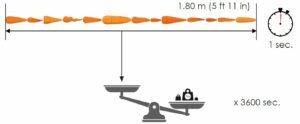
Sortop Potatoes VP03-W / Sortop Multi VP03W:
The hourly output depends heavily on the calibre and the condition of the product to be sorted. The sorting capacity is at 1.40 m potatoes per second. In order to maintain the hourly output, 1.40 m potatoes must be lined up one after the other (large and small – realistic extract from the product). The weight of 1.40 m potatoes per second extrapolated to one hour (x3600 sec.) results in the hourly sorting capacity.
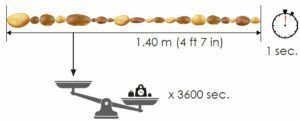
Sortop Potatoes VP02-UW:
The sorting capacity is between 1.5 and 4 tons per hour depending on the average size of the potatoes.
2.8 - How much compressed air does an optical sorting machine use?
500 l/min, per ton of product processed
- @ 6.5 bar for carrots
- @ 8 bar for potatoes
Attention : Minimum air quality according to ISO8573-1:2010 [3.3.2]; if food compliance required: [1.3.1]
2.9 - Which power supply is needed for an optical sorting machine?
All machines: 3L+N+PE, 400 V; 50 Hz; 16 A
Attention norm UL: Three-phase four-wire wye 277/480VAC 60 Hz + earth safety ground. 16A. (No high-leg or corner-grounded!)
All machines: The power consumption is 10 A.
2.10 - How does the feeding of the optical sorting machine work?
Sortop Carrots VC03 / Sortop Multi VP03-W:
A simple and ingenious rotating system aligns carrots of all sizes, smoothly and nearly without any duplicates. This results in a massively increased hourly sorting capacity.
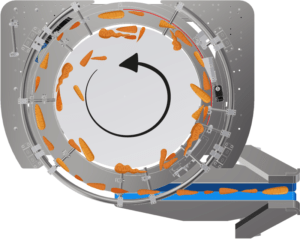
Sortop Potatoes VP03-W / Sortop Multi VP03-W:
A simple and ingenious rotating system aligns potatoes of all sizes, smoothly and with only a few duplicates. An accelerator then pulls the potatoes apart so that they are lined up without being laid twice. This results in a massively increased hourly sorting capacity.
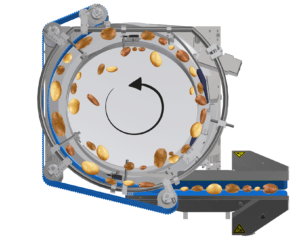
Sortop Potatoes VP02-UW
A robust belt system aligns potatoes of all sizes, smoothly and almost without any duplicates. The sorting capacity is between 1.5 and 4 tons per hour depending on the average size of the potatoes.
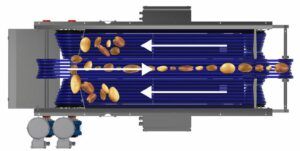
2.11 - How does the optical analysis work?
Thanks to a mirror system and a very powerful all-round lighting that eliminates shadows, every vegetable is subjected to a perfect 360° analysis. The optical system generates 3 immaculate high-resolution images of each carrot/potato. These can be displayed immediately on the computer screen to check the error detection.
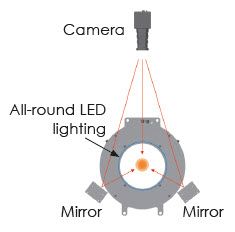

Example: 3 immaculate images
- High-resolution color and infrared camera, error detection from 0.16 mm2
- Visualization of images with display of error detection
- Accepts all shapes of carrots
– Calibrates sizes from 10 to 80 mm, length up to 500 mm
– Calibration accuracy at 1 mm, weight estimate at 1 g - Accepts all shapes of potatoes
Fine calibration 20 mm to 90 mm square mesh grading, calibration by the weight of each tuber with a 5% accuracy.
2.12 - How many quality levels are there?
The software allows an easy setting of 5 quality levels (plus waste). The extra quality product volume is increased, and the amount of waste is reduced to a minimum. Thanks to the accuracy of the setting and the unique sorting consistency of the software, a significantly higher yield per batch is achieved.
2.13 - How does the ejection of products work to the assigned outputs?
A nozzle system blows the products towards the assigned outputs with extreme precision. The fall is cushioned by soft materials that guarantee a smooth landing.
2.14 - How many different outputs are possible?
Sortop Carrots:
There are 4 to 16 parameterizable outputs available. The products of each exit are passed onto individual conveyor belts. The sorting criteria can easily be adapted to the specific needs of each customer.
Sortop Potatoes/Sortop Multi:
There are 6 parameterizable outputs available. The products of each exit are passed onto individual conveyor belts. The sorting criteria can easily be adapted to the specific needs of each customer.
2.15 - Which defects does the optical sorting machine recognize and which does it not?
Sortop Carrots VC03
For clarity, the following points are included:
-
- Detection of all types of visible contrast defects up to a size of 0.16 mm2.
- Detection of mouse bites
- Bended and forked carrots detection
- Broken carrots detection.
- Green crowns detection.
- Ability to sort carrots by diameter, length and/or weight.
- Sizing accuracy by diameter of 0.5 mm, rounded to the nearest whole millimetre.
- Sizing accuracy by length of 3 mm (except rootlet or stem presence).
- Sizing accuracy by weight of 3%.
- Sorting of all carrots under diameter of 85 mm.
- Sorting of yellow carrots possible without restriction.
- Sorting of purple carrots, analysing size and shape.
- Stem size detection and sorting.
- White tip length detection and sorting.
- Selection of 5 sorting quality levels plus waste.
- The appreciation of sorting result is somewhat subjective. The machine will reproduce the quality appreciation of the customer.
- Any discrepancy in sorting to be measured over an 8 hour day to give a fair average.
- The sorting may be impaired for an exceptionally bad crop (for example large proportion of broken tips).
- The reference gross weight used for the warranty is given by the sorter software Visar VACS.
For clarity, the following points are excluded:
-
- Internal rotten crowns (if invisible from the top to the naked eye)
- Mechanical damages (if the colour contrast does not allow detection)
- Small rotten tips (less than 3mm on the very end of the carrot tip)
- Uncharacteristic taints or odours
- Many of those defects are detected but we cannot give warranty that the Sortop Carrots see them all
Sortop Potatoes VP02-UW
For clarity, the following points are included:
-
- Detection of all types of visible contrast defects up to a size of 0.16 mm2.
- Selection of 5 sorting quality levels plus waste.
- Ability to sort the potatoes by the square mesh, length and/or weight.
- Sizing accuracy by 1 mm at the square mesh or maximal diameter.
- Elimination of minimum 98% stones, clods of earth and various foreign elements.
- Limited sorting capacity for potatoes larger than 80 mm.
- Sorting of potatoes of various colours possible without restriction.
- The detection of the defects on the unwashed potatoes depends on cleanliness of tubers. Under equal working conditions, the sorting performance is comparable to that of humans.
- Within the restrictions listed above, compliance with the usual commercial quality standards for potato deliveries is guaranteed.
- The above guarantees do not apply to wet and/or dirty potatoes.
For clarity, the following points are excluded:
-
- Internal defects are not visible.
- The detection of the fresh mechanical damages, that do not cause any visible fading of the tubers, is not guaranteed.
- Differentiation between Rhizoctonia and wireworm holes is not possible.
Sortop Potatoes VP03-W / Sortop Multi
For clarity, the following points are included:
-
- Detection of all types of visible contrast defects up to a size of 0.16 mm2.
- Selection of 5 sorting quality levels plus waste.
- Ability to sort the potatoes by the square mesh, length and/or weight
- Sizing accuracy by 1 mm at the square mesh or maximal diameter
- Elimination of minimum 98% stones, clods of earth and various foreign elements on pre-washed potatoes
- Limited sorting capacity for potatoes larger than 80 mm
- Ability to sort potatoes of various colours
- The detection of the defects on the washed potatoes depends on cleanliness of tubers. Under equal working conditions, the sorting performance is comparable to that of humans.
- Within the restrictions listed above, compliance with the usual commercial quality standards for potato deliveries is guaranteed
- The above guarantees do not apply to unwashed potatoes
For clarity, the following points are excluded:
-
- Internal defects are not visible.
- The detection of the fresh mechanical damages, that do not cause any visible fading of the tubers, is not guaranteed.
- Differentiation between Rhizoctonia and wireworm holes is not possible.
2.16 - Which parameters can be used for sorting?
Carrots:
Calibration:
- Length
- Calibre (Thickness)
- Weight
Qualitative sorting:
- Form
- Broken carrots
- Stains
- Green crowns
- Length of the cabbage
- Length of the white tips
Potatoes:
Calibration:
- Length
- Calibre (Thickness) / square mesh
- Weight
Qualitative sorting:
- Form
- Stains
- Green stains
- Wireworm holes
2.17 - How are the computer and the electrical control integrated?
The computer and the electrical control are perfectly integrated in a waterproof control cabinet in the machine.
3. Software Visar VACS
3.1 - How does Software Visar VACS work?
The principle is based on artificial intelligence, which enables the subjective evaluation of the quality, shape and appearance of each vegetable and thereby replicates the human appreciation. Combined with other measurable criteria (for example such as surface defects, length of vegetables, etc.), this setting allows the fine-tuning of the sorting accuracy.
3.2 - What is unique about the software Visar VACS?
Artificial intelligence allows a consistent and immediate adjustment of severity according to your quality needs.:
- A person evaluates the quality of the vegetables by precisely visualizing and analyzing the entire surface of the vegetable.
- Its assessment is global by combining both quantifiable and subjective information.
- The severity of its selection criteria may vary according to its need for quality.
- It allows a consistent and immediate adjustment of severity according to the need for quality.
3.3 - Is the traceability of each batch possible?
Yes, every batch can be fully traced.
3.4 - What are the criteria of the statistics?
- Sorted gross weight
- Weight per category / output
- Time
- Sorting date
- Supplier parameters (address and name)
- Batch number
3.5 - In what form are statistics provided?
- Excel table for each batch
- Summary excel table of all batches (ongoing)
3.6 - Are there any software updates? Will I be informed about them? Are these chargeable?
Yes, there is a software update approximately every 2 years. Every customer will be informed about this. The software update can be downloaded to your machine at any time. Any further developments of the mechanical elements as well as the software update will be invoiced. Software updates are installed free of charge during the warranty period.
3.7- How is the Visar VACS software set or adapted?
The software is adapted to your needs in advance. Fine adjustments are made during commissioning and your staff is trained in detail at this point. We offer an online support to help you to configure the software. The online support is included in the purchase price for the first year.
3.8 - Can the quality requirements be adjusted at any time?
Yes, all parameters can be adjusted at any time.
3.9 - How long does it take to set the software?
Factory settings are immediately operational. The machine does not necessarily have to go through a learning period to be able to sort according to your specific needs, but it can.
The necessary time is simply the time for the choices of the outlets which you will use for the different qualities and sizes of your product. If you have already made your choices before starting the machine, it will only take a few minutes.
3.10 - Is it difficult to use the software?
No, there is a very short learning period. All the choices are made easy by the software’s logical architecture. Visar Sorting Sàrl provides a quick and high availability support in case of need.
4. Service / Maintenance
4.1 - Does the optical sorting machine require regular cleaning?
The machine should be cleaned regularly (simple daily cleaning and complete weekly cleaning), depending on use, according to user manual.
4.2 - Does the optical sorting machine require regular maintenance?
The machine must be maintained regularly, depending on use, according to the user manual. A checklist and an annual maintenance checklist are provided by Visar Sorting Sàrl.
4.3 - Who can / may perform the annual maintenance work?
Annual maintenance can be carried out by Visar Sorting Sàrl or one of our partners. Visar Sorting Sàrl or our partner can also train your staff so that you can carry out the annual maintenance yourself (warranty is only valid if original spare parts are used).
4.4 - Where can I get information and request help in the event of a malfunction?
You can obtain information and request aid from our partners where you acquired the machine or directly from Visar Sorting Sàrl at the number +41 21 887 03 01 (EN/DE/FR). You can reach us 7 days a week.
4.5 - Where and for how long are spare parts available?
- Spare parts can be obtained directly from Visar Sorting Sàrl or from one of our partners. These are available for at least 15 years.
5. Safety
5.1 - Which guidelines and standards were taken into consideration in the development and construction of the optical sorting machines?
The machines were designed and developed in accordance with the generally applicable Machinery Directive. The CE/UL guidelines were also observed. The machines are food compliant. In accordance with the EC declaration of conformity, the CE marking is provided on the nameplate of every machine.
5.2 - What operating safety devices are there on optical sorting machines?
- Automatic optical fault detection system
- Automatic control of the waste rate – limitation
- Automatic control of sorting variation
- Automatic blockage control
6. Conditions
6.1 - How long is the warranty?
The warranty claims become statue-barred after 12 months or after 2500 machine hours after delivery of the object of sale (the value reached first counts). The warranty is only valid if original spare parts are used.
6.2 - What is the delivery time?
The delivery time is approx. 24 weeks after receipt of the deposit.
6.3 - What are the delivery conditions?
Delivery ex works CH-1047 Oppens – EXW INCOTREMS 2020.
Stay up do date!
Sign up for the newsletter now and don’t miss anything.
